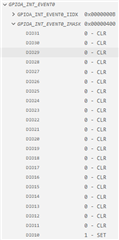Tool/software:
Hello.
I have a question about the behavior of the MSPM0G1506 after a BOR reset.
I intentionally caused a BOR reset by manipulating the power supply.
The BOR level was set to 1, and the power supply was changed from 2.3V to 2.0V, then back to 2.3V.
I was able to confirm that the MAPM0G1506 reset, but after the reset it stopped responding to interrupts.
When I turned the power back on, it started responding to interrupts.
My questions are as follows.
1) Are there any specifications that would prevent functions such as interrupts from being used after a BOR reset?
2) If I leave it at 2.0V instead of returning it to 2.3V, how will the MSP behave? Will it keep resetting all the time?
Thank you in advance.
-Tsuchiya


